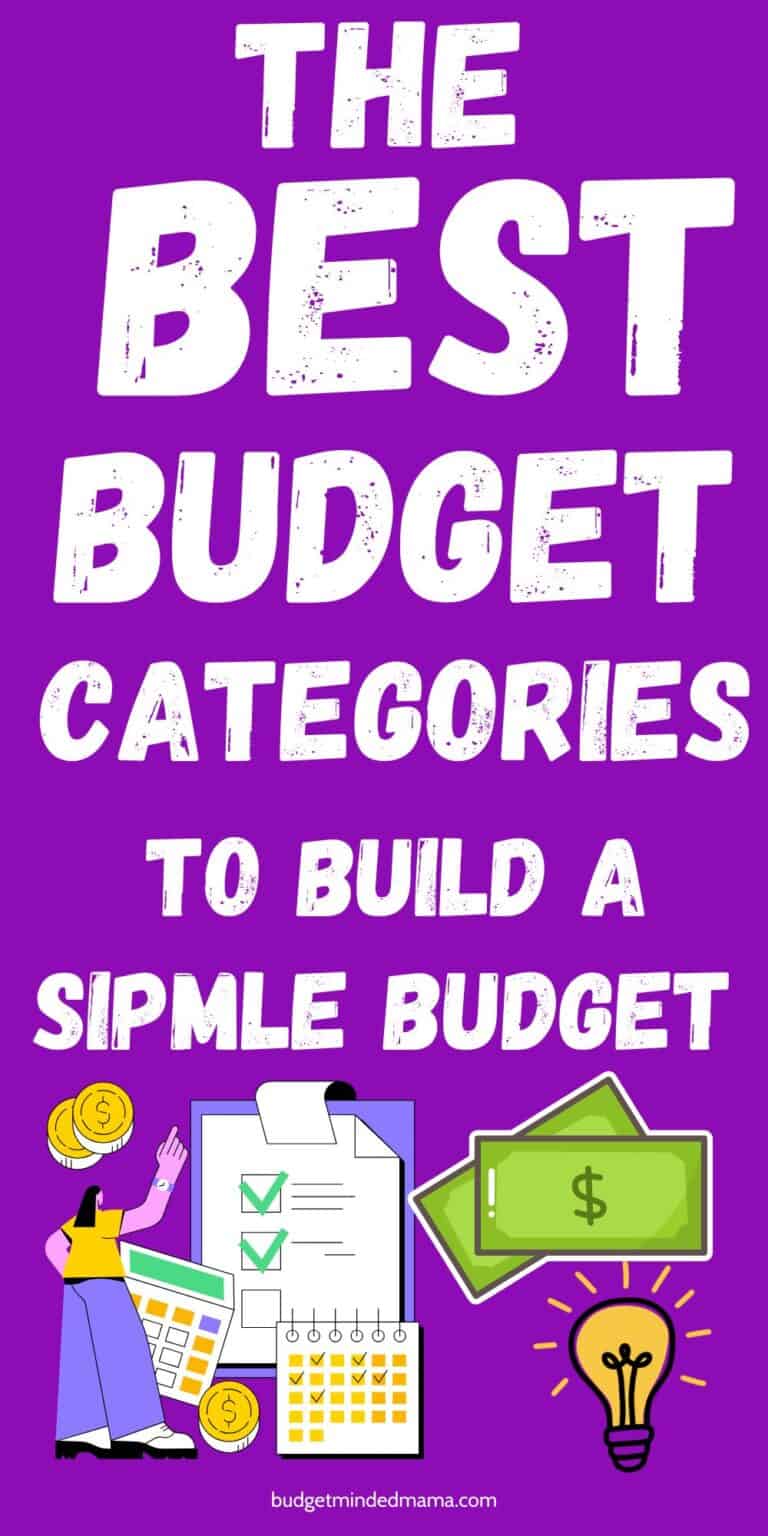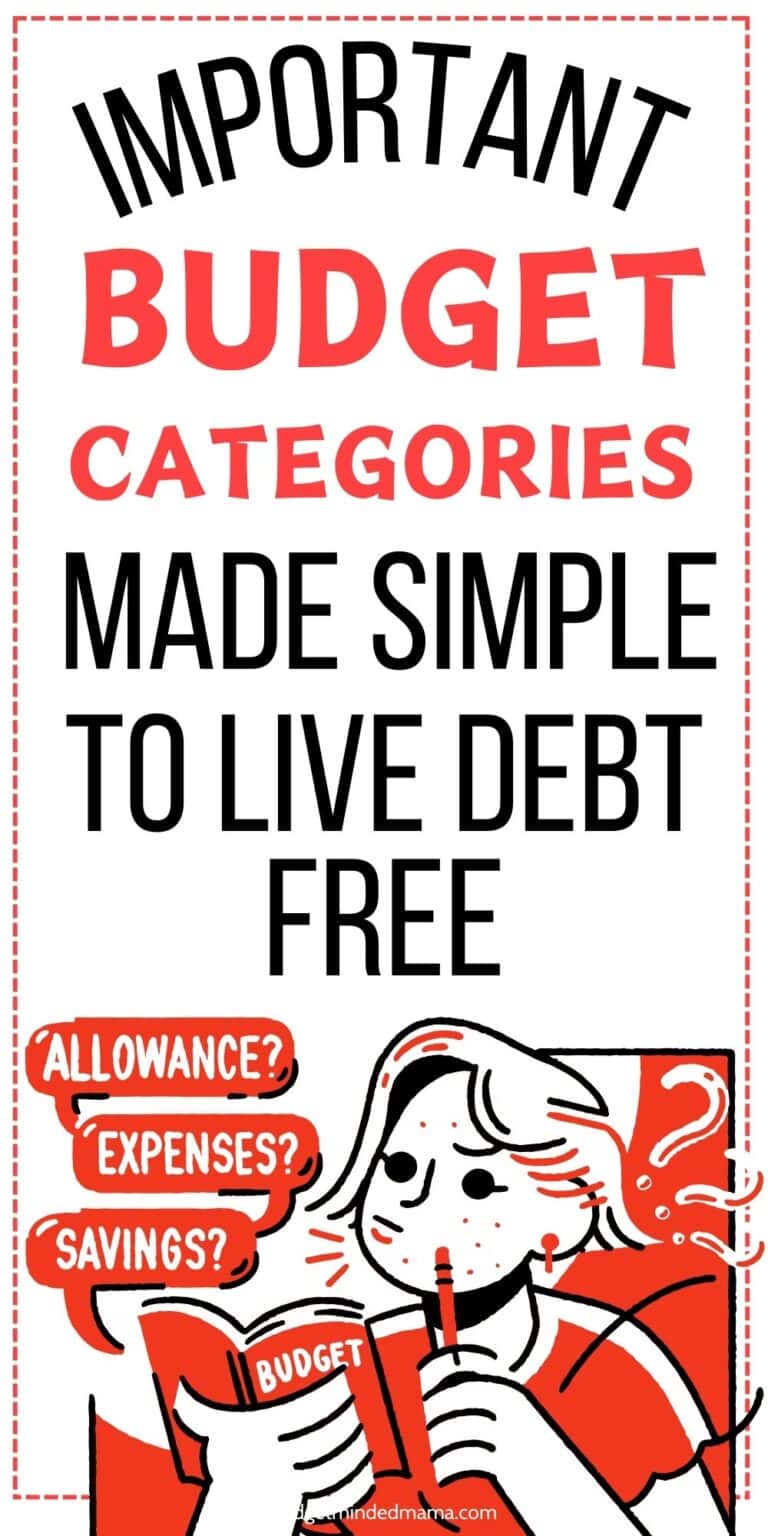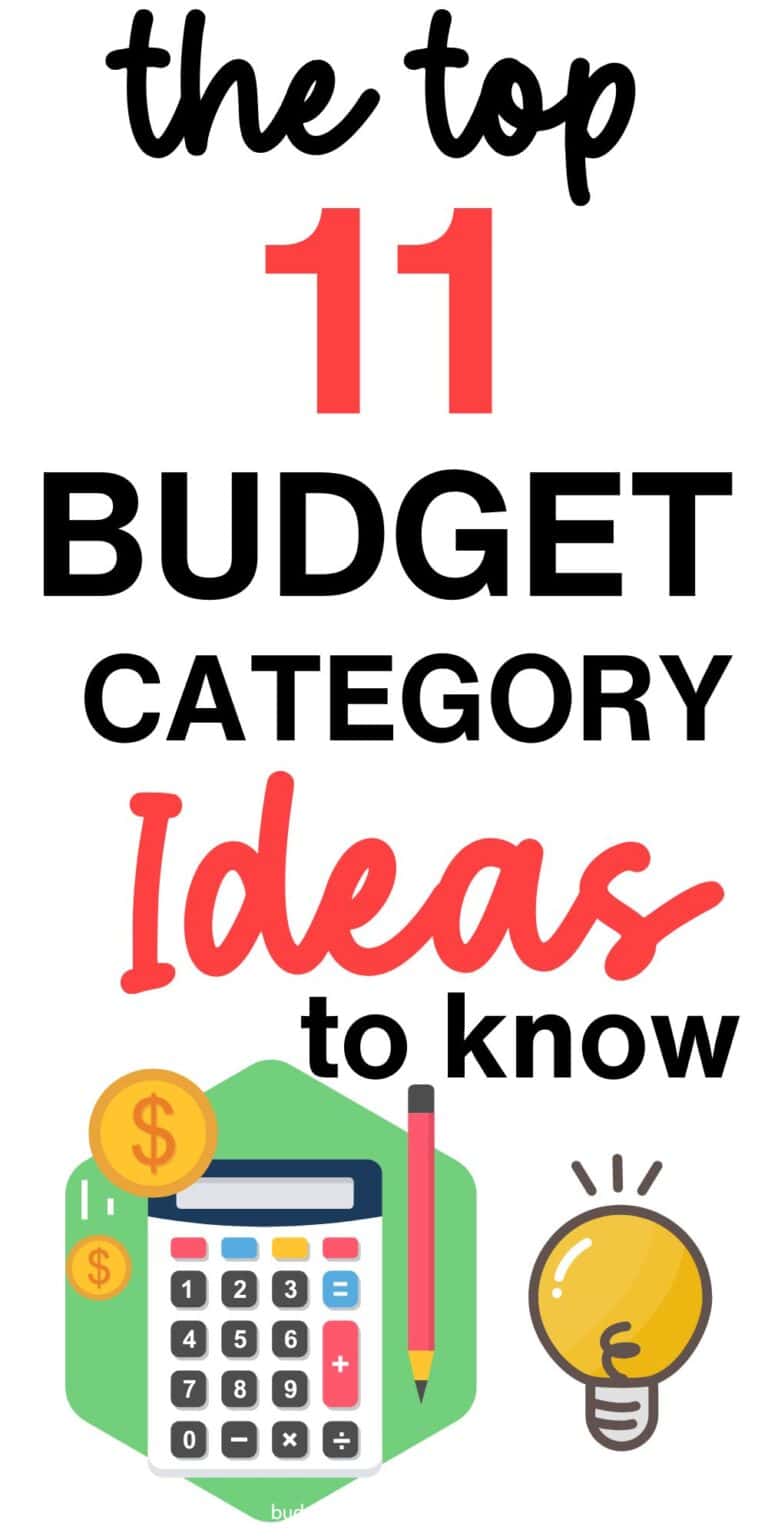Creating a budget doesn’t have to feel like pulling teeth—or cutting out every fun thing you love.

The trick?
Having the right budget categories lined up so you can actually see where your money’s going and where it needs to go.
When I first started budgeting, I tried to wing it with a random list of expenses.
Spoiler alert: it didn’t work.
But once I found a simple way to break things down, it all started to click.
Sound familiar?
Don’t worry!
I’m sharing the ultimate list of budget categories to help you build a budget that’s easy to follow and fits your life.
Categories You Need For a Budget
Setting up your budget is so much easier when you’ve got the right home budget categories in place.
They help you organize your spending, plan for expenses, and avoid those “uh-oh” moments when bills or surprise costs pop up.
A little structure goes a long way toward keeping your finances on track without feeling like a chore!
Housing

Housing is often the biggest expense in any budget, covering everything from rent or mortgage payments to utilities.
It’s important to factor in all the related costs, like property taxes and maintenance, so you’re not caught off guard.
Don’t forget about smaller things like home repairs or supplies—they add up faster than you think.
Keeping this category realistic can help avoid overcommitting to a home you can’t comfortably afford.
- Rent or mortgage payments: Include the full amount, even if you pay bi-weekly.
- Utilities: Cover electricity, water, gas, and any other necessary services.
- Maintenance and repairs: Plan for ongoing upkeep and unexpected fixes.
- Home supplies: Think cleaning products, light bulbs, and other essentials.
Stick to a housing budget that’s no more than 30% of your income.
Set up a home maintenance fund for those “leaky faucet” moments.
Be mindful of energy use—small changes can lower utility bills.
If rent feels overwhelming, consider house-sharing or renegotiating your lease.
Transportation

Transportation includes getting where you need to go, from daily commutes to family road trips.
This category covers car payments, fuel, maintenance, insurance, and public transit costs.
Don’t forget to plan for unexpected expenses like flat tires or rideshare fees.
Keeping track of these costs helps avoid scrambling when the gas tank or car needs attention.
- Car payments: Include your monthly loan or lease payment.
- Fuel: Estimate based on regular driving habits.
- Maintenance: Budget for oil changes, tires, and yearly inspections.
- Public transit: Cover monthly passes, ride tickets, or occasional rideshares.
Track your mileage to estimate fuel needs more accurately.
Bundle car insurance with other policies to save money.
Schedule routine maintenance to prevent larger, costly repairs.
If possible, carpool or use public transit to cut fuel and wear-and-tear costs.
Food

Food expenses go beyond just groceries—they include dining out, takeout, and snacks.
Grocery shopping is typically the biggest chunk here, so plan your trips with a list to avoid overspending.
Be sure to budget for treats or special meals to keep things enjoyable.
A balanced food budget keeps your family fed without draining your wallet.
- Groceries: Cover weekly staples and meal ingredients.
- Dining out: Allocate for family dinners or quick lunches.
- Snacks and beverages: Don’t forget coffee runs or vending machine buys.
- Special occasions: Plan for birthdays, holidays, or hosting guests.
Shop sales and use coupons or apps to stretch your grocery dollars.
Plan meals to avoid food waste and last-minute takeout.
Set a dining-out limit so it feels like a treat, not a habit.
Keep a running list of pantry basics to avoid overbuying what you already have.
Health and Wellness

This category ensures you’re covered for medical, dental, and mental health needs.
It also includes fitness expenses like gym memberships or yoga classes.
From doctor’s appointments to prescriptions, tracking these costs helps avoid surprises.
Prioritizing your family’s health is an investment in your overall well-being.
- Medical: Budget for doctor visits, check-ups, and urgent care.
- Dental: Include cleanings, fillings, and orthodontics if needed.
- Prescriptions: Set aside funds for recurring medications.
- Fitness: Account for gym memberships, workout gear, or classes.
Stay on top of routine check-ups to catch issues early.
Look for family plans on fitness memberships to save money.
Ask about generic prescription options to lower pharmacy costs.
Consider free or low-cost workout alternatives like YouTube or local trails.
Debt Payments

This category focuses on making progress with loans and credit cards while setting money aside for the future.
It’s important to prioritize high-interest debt but still save for emergencies.
A healthy balance here sets you up for financial security.
- Debt payments: Include credit cards, student loans, and personal loans.
- Extra payments: Allocate funds for paying off debt faster when possible.
Focus on paying more than the minimum on high-interest debt.
Use windfalls like tax refunds to boost debt payments.
Track your progress regularly to stay motivated and adjust as needed.
Family and Childcare

Family expenses go beyond just food and housing, especially if you have kids.
This category covers childcare, school supplies, and extracurricular activities.
Don’t forget about things like birthday parties or seasonal expenses like summer camp.
A clear plan helps you manage the unexpected costs of raising a family.
- Childcare: Include daycare, babysitters, or after-school programs.
- School supplies: Budget for books, backpacks, and technology needs.
- Extracurriculars: Cover sports fees, music lessons, or dance classes.
- Seasonal expenses: Plan for holidays, summer camp, or back-to-school shopping.
Look for free or low-cost local activities for kids.
Shop sales early for school supplies to avoid last-minute markups.
Swap babysitting duties with other parents to save on childcare costs.
Be realistic about how many activities your child can manage without breaking the bank.
Personal Expenses

This is the “me time” category, covering everything from haircuts to hobbies.
It’s important to give yourself a little wiggle room here to avoid burnout.
Personal expenses also include clothing, self-care products, and anything you spend on yourself.
Having a set amount keeps this category guilt-free and enjoyable.
- Self-care: Include haircuts, spa visits, or grooming products.
- Clothing: Budget for seasonal updates or special events.
- Hobbies: Allocate for crafting, gaming, or other passions.
- Education: Cover online courses or books for personal growth.
Set limits for fun spending, but don’t eliminate it entirely.
Look for deals on clothing or self-care services to stretch your budget.
Prioritize hobbies that bring lasting joy instead of fleeting satisfaction.
Schedule “me time” into your routine so it feels intentional, not impulsive.
Insurance and Subscriptions

This category keeps you covered for life’s unexpected events and your favorite conveniences.
From health and car insurance to streaming services, these costs add up quickly.
Knowing what you’re subscribed to—and what you actually use—is key.
Reviewing this category often can help you cut down on unnecessary expenses.
- Insurance: Cover health, home, auto, and life insurance premiums.
- Subscriptions: Include streaming services, apps, or subscription boxes.
- Memberships: Budget for things like AAA or warehouse clubs.
- Warranty plans: Factor in protection plans for electronics or appliances.
Shop around for insurance quotes regularly to find better rates.
Cancel unused subscriptions to free up extra cash.
Bundle insurance policies for potential savings.
Track renewal dates so you’re not caught by surprise charges.
Entertainment and Recreation

Keeping life fun is important, even on a tight budget.
Entertainment includes things like movie nights, concerts, or family outings.
Recreation could mean memberships to museums, parks, or other activities you enjoy.
Planning for this category helps keep you from feeling deprived.
- Family outings: Budget for zoos, museums, or amusement parks.
- Events: Plan for concerts, festivals, or sports games.
- Hobbies: Allocate for recreational activities like fishing or hiking.
Look for free or low-cost events in your community.
Make movie nights at home special with popcorn and blankets.
Use memberships or passes to save on frequently visited spots.
Balance big-ticket experiences with smaller, more affordable ones.
Miscellaneous

This category is your safety net for anything that doesn’t fit neatly elsewhere.
It’s perfect for things like unexpected gifts, random fees, or one-off purchases.
Having a little room here can help avoid dipping into savings unnecessarily.
Think of it as the catch-all that keeps your budget flexible.
- Gifts: Include birthdays, holidays, or just-because presents.
- Fees: Plan for bank charges or parking tickets.
- One-off purchases: Budget for random needs like batteries or stamps.
- Donations: Cover charity contributions or school fundraisers.
Keep this category small but effective—it’s not a “miscellaneous splurge” fund.
Adjust amounts if you notice repeated costs that fit another category better.
Track these expenses to identify patterns you can plan for in the future.
Avoid overspending here by treating it as a backup, not a free-for-all.
Savings

Savings is your future-focused category, covering short-term goals and long-term dreams.
It’s more than just an emergency fund—it includes things like vacations, holiday shopping, or buying a new car.
Having clear savings goals keeps you motivated and helps you prioritize.
This category is all about making progress on what matters most to you.
- Emergency fund: Set aside 3–6 months of expenses for the unexpected.
- Vacation fund: Save for trips or weekend getaways.
- Holiday savings: Budget for gifts, decorations, and travel.
- Big purchases: Plan for things like a car, home renovations, or new appliances.
Automate your savings to make it a no-brainer.
Use visual trackers to see your progress and stay motivated.
Split savings goals into smaller, manageable steps to make them feel achievable.
Revisit your goals regularly to celebrate milestones and adjust as needed.
Building a Budget That Works for You
Creating a budget is all about finding a system that fits your life and makes managing your money feel doable.
By organizing your spending into clear categories, you’ll have a better handle on where your money is going—and where it’s needed most.
Remember, a good budget isn’t about restrictions; it’s about giving you control and helping you focus on what matters most.
Start with these categories, make adjustments as you go, and watch how small changes can make a big impact!
Make sure to follow me for more budgeting help!



